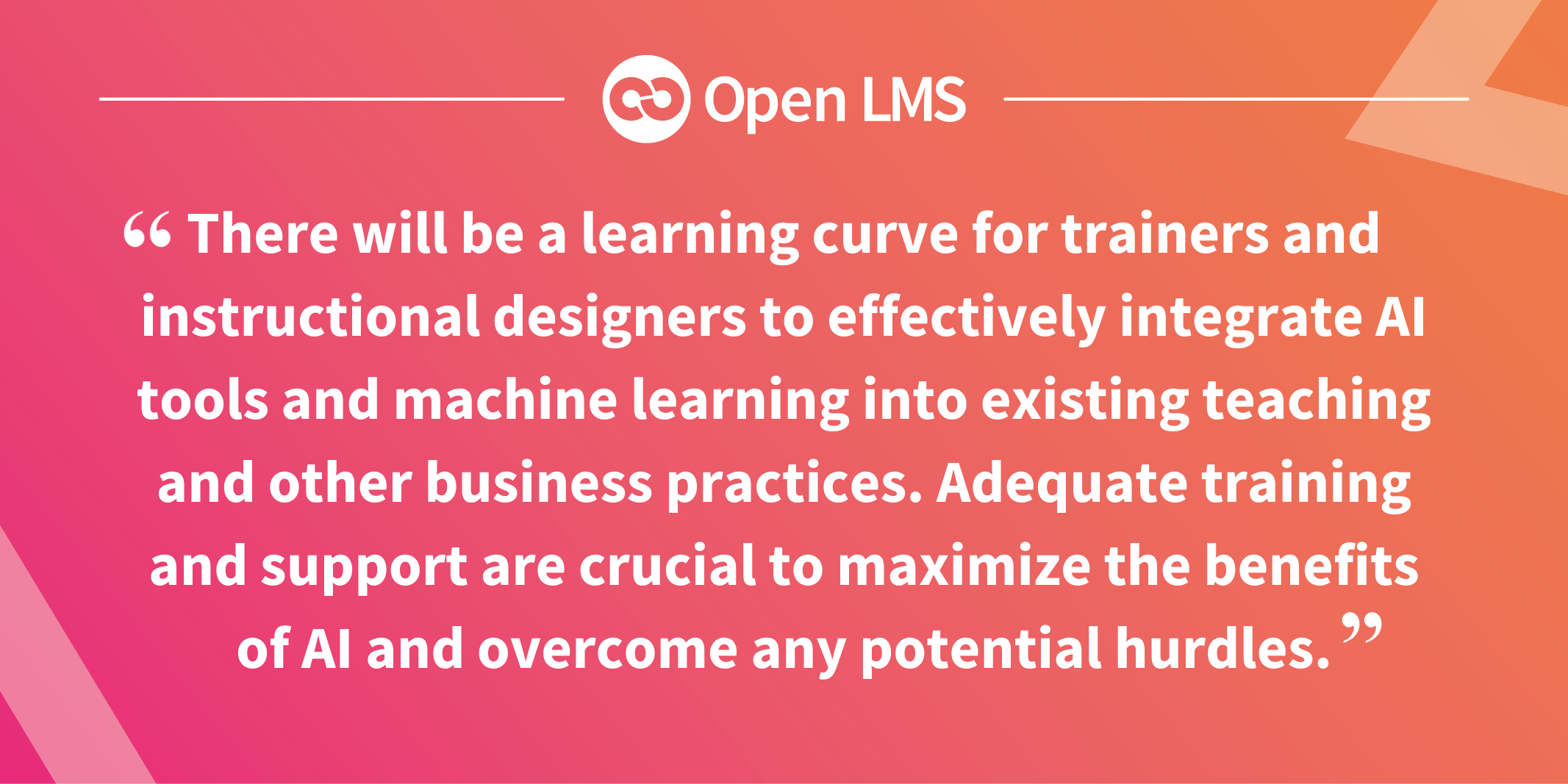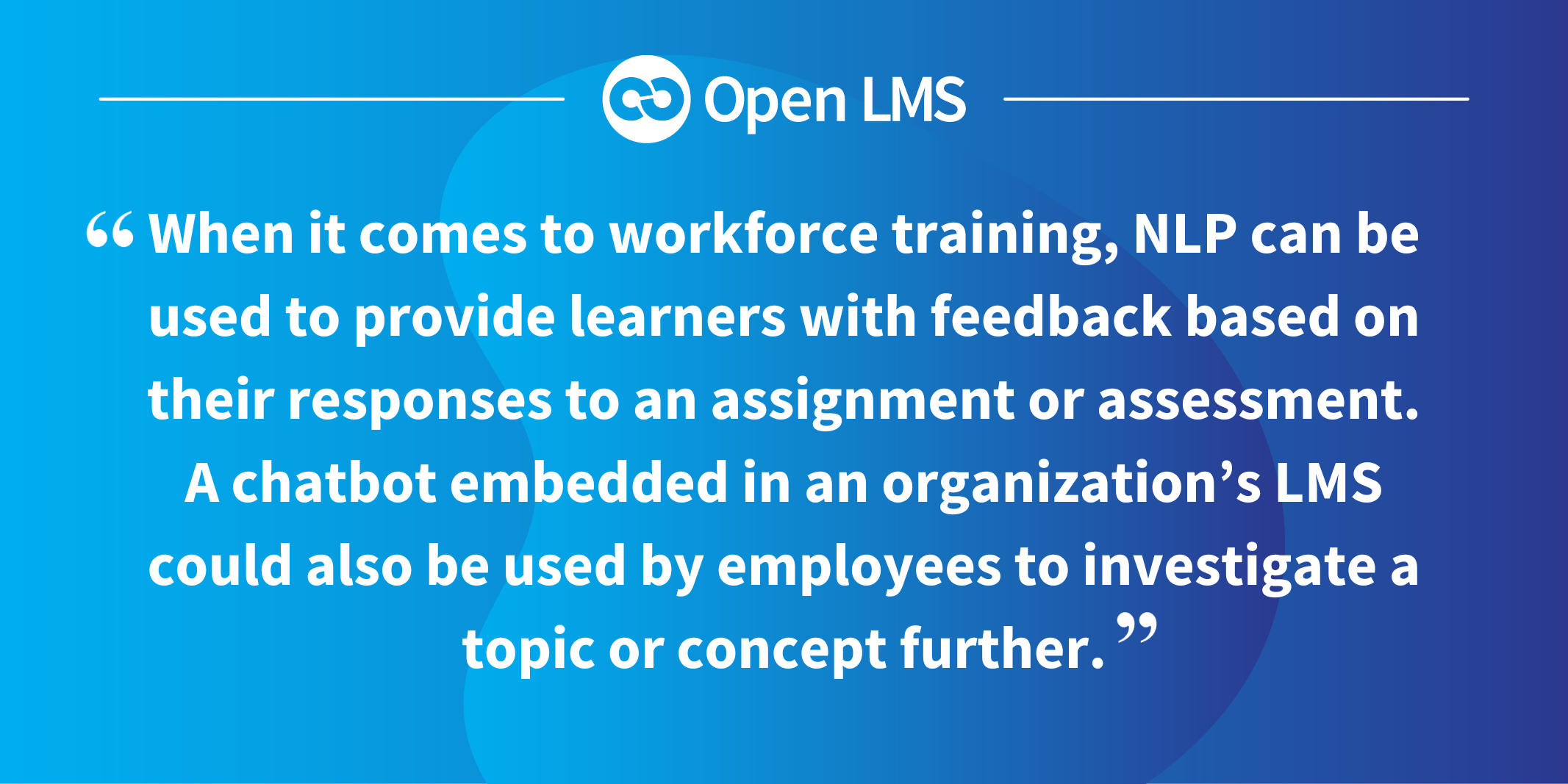4 Powerful Applications of AI and Machine Learning in Corporate Training
AI, VR, AR, learner analytics, hybrid learning, micro-credentials... It’s easy to brush off these terms as mere buzzwords, but staying “in the know” about tech innovations is vital to your organization’s success. More than 86% of companies expect to increase their implementation of new and frontier technologies by 2028. To stay competitive and ensure employees are prepared, organizations must keep up with the seemingly breakneck pace of technological advances, and that means making sure workers are adequately trained using trending technologies.
While artificial intelligence (AI) and other learning technologies aren’t brand-new concepts, companies are getting more imaginative with how they’re implementing them. From streamlining processes to increasing productivity, these tech tools are redefining how job functions are performed as well as the skillsets employees need to employ in order to be successful at work. Pairing new tech with existing tech, like a business learning management system (LMS), can bring new ideas, increase learner engagement, and help drive company goals.
Keep reading as we look at four uses of AI and machine learning in corporate training programs.
First, Let’s Define AI and Machine Learning
AI and machine learning are decades-old technologies that have recently emerged as revolutionary tools in several industries. AI refers to a machine’s ability to simulate human thought processes, such as analyzing data, learning from patterns, and making informed decisions.
Machine learning is a subset of AI that focuses on enabling systems to automatically learn and improve from experience without explicit programming. Machine learning has been deployed in numerous capacities since the early 1970s, and variations of AI technologies have existed in our everyday lives for years.
In a corporate training context, AI and machine learning can personalize the employee learning experience, support learner success, and streamline teaching processes, leaving instructors with more time to work directly with learners and to help meet their needs.
AI-powered tools can be used to:
- Write multiple-choice questions
- Generate essay prompts
- Develop training plans
- Evaluate assessments
- Identify at-risk employees
- Provide learners with timely feedback
- Suggest relevant learning content

This automation frees up instructors’ time because they’re not spending hours or days sourcing material, writing assessments, or aligning training goals to those of their organization. AI and machine learning also improve the learner experience by tailoring feedback and suggestions to each worker’s educational needs.
However, AI implementation does come with its challenges. Ethical considerations and privacy concerns arise when collecting and analyzing large amounts of employee data. Organizations need to ensure proper data protection measures and transparent data usage policies to maintain trust between workers and the company.
Additionally, there will be a learning curve for trainers and instructional designers to effectively integrate AI tools and machine learning into existing teaching and other business practices. Adequate training and support are crucial to maximize the benefits of AI and overcome any potential hurdles.
Despite these challenges, harnessing the power of AI and machine learning can create dynamic, personalized, and efficient learning environments. We explore the following four AI and machine learning applications in more detail below:
- Natural Language Processing (NLP)
- Computer vision
- Personalized learning with recommendation systems
- Predictive analytics
MORE TO READ ON AI-POWERED LEARNING | ‘3 Ways to Leverage an LMS to Promote the Proper Use of AI Tools Among Students’

Application #1: Natural Language Processing (NLP)
NLP is a branch of computer science concerning AI and how computers understand written and spoken language in a similar manner to humans. Virtual assistants and chatbots like ChatGPT use NLP to interpret written or spoken prompts from human users. The AI tool then generates a response to the prompt based on its information database.
When it comes to workforce training, NLP can be used to provide learners with feedback based on their responses to an assignment or assessment. A chatbot embedded in an organization’s learning management system could also be used by employees to investigate a topic or concept further as they move through instructional modules.
Instructors can also use NLP technology to assist in content development, lesson planning, and assessment grading. LMS chatbots can also assist with differentiating content for specific learners according to their learning pathways or job functions.
WANT TO CREATE BETTER ASSESSMENTS? READ THIS! ‘How to Improve Your Digital Training Programs With Formative Assessment’
Application #2: Computer Vision
Computer vision is a subcategory of AI focused on creating and using digital systems to process, analyze, and interpret digital visual data. With this technology, computer devices can “see” objects with image processing and pattern recognition. The computer interprets what it “sees” and takes appropriate actions.
In mainstream usage, computer vision technology is what powers crash detection and self-parking on newer vehicles equipped with the appropriate sensors and hardware. A car’s computer learns to recognize driving patterns and “sees” traffic, enabling the vehicle to react appropriately when it gets too close to another object (like slamming on the brakes if it detects a pedestrian on the road).
Due to its ability to interpret objects in the real world, computer vision technology can be used to develop augmented reality (AR) experiences for learners. The technology helps the computer recognize objects and accurately overlay supplementary information onto the real world.
The combination of computer vision and AR tech can produce simulations that may prove especially helpful for assessing hands-on concepts. Lessons that might not otherwise be easily taught in an all-digital setting, like a nurse demonstrating compliance with triage procedures, can be completed using an augmented reality experience.
MORE FROM THE BLOG | ‘Creating Real-Life Learning Experiences: Augmented Reality in Education’
Application #3: Personalized Learning With Recommendation Systems
AI-powered recommendation systems leverage algorithms to analyze vast amounts of learner data, such as:
- Learner preferences
- Behavior patterns
- Performance data
By leveraging data collected from learners’ interactions with a corporate LMS, AI can generate personalized recommendations, content, and pathways tailored to individual employees. This allows learners to work at their own pace while addressing their unique needs and learning styles.

HANDPICKED FOR YOU | ‘How to Deliver Personalized Learning’
Application #4: Predictive Analytics
By analyzing historical learner data and applying machine learning algorithms, predictive analytics is an AI tool that can provide valuable insights and inform decision-making processes in eLearning environments.
Various data points, such as learner engagement, assessment performance, and interaction patterns, are used by the AI to identify learners who might be struggling or experiencing academic difficulties. Additionally, predictive analytics can be used to optimize instructional design and content delivery:
- By analyzing learner data and performance outcomes, predictive analytics can identify learner patterns and trends that inform the design of instructional materials, course structure, or assessment strategies.
- By analyzing the data on learners’ interaction patterns and engagement within an LMS, predictive analytics can suggest content modifications that might enhance instructional materials or increase learners’ engagement.
As you can see, AI and machine learning applications can significantly advance corporate training, from computer-generated speech that provides accurate feedback to gathering precise and valuable analytics to enhance your whole training program. As the technology continues to develop, new and unexpected applications will emerge. For corporate L&D, we believe that now isn’t the time to be mere observers but to make the most of this transformation.
